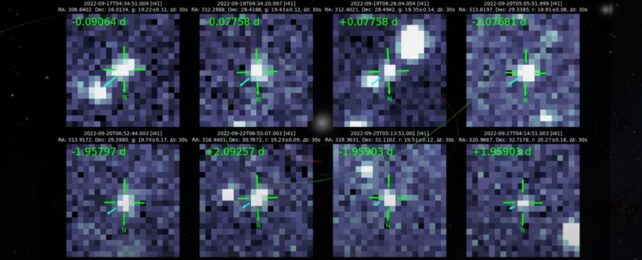Humanity has been on an asteroid-finding spree as of late. Those close to Earth, known as Near Earth Objects (NEOs), have been particularly interesting for two reasons.
One is they offer potentially lucrative economic opportunities with asteroid mining. The other is they are potentially devastating if they hit the Earth, so we'd like to find them with some advance warning.
Those that fall into the latter category are known as potentially hazardous asteroids, or PHAs. Now, thanks to some ingenious programmers from the University of Washington, we have a new algorithm to detect them.

Of the 30,000 total NEOs found so far, about 2,300 of them are PHAs. However, researchers think there are at least that many left to be discovered. PHAs typically come within 5 million miles of Earth and must be large enough to be a potential threat, not just burn up in our atmosphere as a shooting star.
Finding these dim objects, even when they are on their closest approach, can be a daunting challenge. Scientists typically use specialized telescopes like Asteroid Terrestrial Impact Last Alert System (ATLAS) at the University of Hawai'i.
However, these massive telescopes usually have to image the same patch of sky four times in a single night to catch a glimpse of a PHA on the edge of its detection range.
That's where the new algorithm comes in. Developed by Ari Heinze, a researcher at UW, and Siegfried Eggl, now a professor at the University of Illinois Urbana-Champaign, the algorithm, known as HelioLinc3D, is capable of finding data on asteroids that might be spread throughout observations of multiple days from a single satellite.
Which is precisely what happened when it found its first new PHA. Now known as 2022 SF289, ATLAS originally picked it up during observations on September 19th, 2022, but it was only captured once that night. Luckily, it was captured three more times by ATLAS on two separate nights as well, and HelioLinc3D could piece together the puzzle to find the asteroid hiding in plain sight.
2022 SF289 is not a threat – while its orbital path will take it within 140,000 miles of Earth, it appears unlikely to impact the planet at any point in the foreseeable future. And, at 600 feet (about 180 meters) in length, it likely would be devastating, but not catastrophic, like the asteroid that contributed to the dinosaurs' downfall.
Other observatories also missed discovering it, as it was located in a region of the Milky Way that is awash with background stars, making it difficult to make out a faint, fast-moving rock, even if it is much closer to us. Once discovered, though, it was quickly confirmed by other specialist asteroid hunters like the Catalina Sky Survey and Pan-STARRS.
So, chalk one up for the new algorithm. But that's just the beginning of its contributions. HelioLinc3D was originally developed to work on a much more powerful telescope.
The Vera C. Rubin observatory, planned to come online in Chile in early 2025, is expected only to require two captures a night to detect asteroids like 2022 SF289 rather than the four currently needed. And HelioLinc3D will help it do that.
But until then, it appears it will have plenty of work cut out for it searching through the back catalogs of ATLAS and other asteroid hunters. For our own sakes, we should all wish it the best of luck.
This article was originally published by Universe Today. Read the original article.
